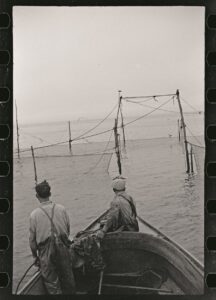When we were kids hanging out at the West End Racing Club in Provincetown or walking the flats in front of our summer digs on Capt. Jack’s Wharf, our ears were always waiting for the sound of shotgun blasts.
We’d hear the first ones in late July. They didn’t happen frequently, but when they did, we’d stop what we were doing and jump into any available sailboat, skiff, or runabout and head as fast as we could to the big fish weir just off the West End flats in the middle of the harbor.
When we heard the shots, we knew the bluefin tuna had arrived. But they weren’t prized game then. Of all the changes in fishing off Cape Cod in the last century, none is more extraordinary than what has happened with bluefin tuna.

Back in the early 1960s, before Provincetown’s legendary sport fishing pioneer, Capt. Charlie Mayo Jr., led the way to the big tuna being recognized as blue-ribbon game fish, bluefins were considered trash fish. Back then, tuna was worth a few cents a pound and was used primarily for cat food and fertilizer.
The fact that there was no market for these fish brought about the shotgun blasts that enraptured a bunch of thrill-seeking kids.
The West End weir was one of three massive Outer Cape fish traps remaining on the bay at that time. There were two others off Truro. Each weir consisted of a long wall of netting that stretched hundreds of yards, hanging from tall wooden posts, funneling all manner of fish species into a large, circular net, or seine, where they would become trapped.
The fishermen who handled the nets did so mainly from trap boats — heavy wooden craft powered by small diesel engines. They would go to the nets, close off the opening to the seine, then carefully draw it together so the catch could be scooped up in nets or with gaffs. The seine would then be placed back on the weir poles and sunk to the bottom, and the purse end was reopened.
While the weirs were perfectly adequate for containing a school of menhaden, mackerel, or even large striped bass, they were no match for the tuna that periodically found their way into the weir.
An enormous tuna entering the weir could cause significant damage to the nets, rigging, and even to the weir poles in a matter of minutes.
When that happened and we heard the blasts, we’d race out and tie our boats to the poles to watch the action. First, the trap boat captain would speed to the town pier and return with a rowboat in tow. The weir would slowly be raised until the tuna, often weighing 500 pounds each or more, were forced onto their sides. The action then began in earnest. When the tuna felt the nets closing in around them, they would thrash their mighty tails, each splash sending water far above the masts of our tiny sailboats and raining down on us.
The best part, it seemed to us, was when a brave fisherman, armed with his sawed-off 12-gauge shotgun, would carefully row up close to one of the panicked tuna, lean over the gunwale, and fire into its head. The fisherman would reload and move to the next fish and repeat the process until all the tuna were dead, then loop a heavy rope around each one’s tail and row them, one by one, out into the bay.
Occasionally, a trap boat crew would keep a fish or two, but most often they would simply be towed out into deeper water and discarded. A sushi-crazed decade later, these fish would be worth $25,000 or more apiece.
In 1964, the U.S. Navy’s 6th Fleet anchored in the bay off North Truro. On a perfectly calm, sunny afternoon we jumped into my pal Peter Van Arsdale’s speedboat and waterskied around the boats. We thought the fleet was spectacular. But even more impressive was what we saw just beneath the surface. Starting within Provincetown Harbor and extending southeast to the Pamet River was a school of bluefin tuna — mile after unbroken mile of them. When we turned off the boat’s motor and drifted, they were so thick and so close you could reach over the side and touch their fins.
Times change. Technically, it’s still tuna season, but the big bluefins never showed up this summer or fall. When a charter boat owner told me he was quitting going after them this year, I felt glad about that and realized how sad I am there are so few around.
The bluefin tuna are still around in midsummer most years, but they’re smaller. And they’re here in numbers that pale by comparison to what we saw as boys. People in labs are working on propagating tuna in hopes of keeping their valuable meat in markets everywhere.
That leaves us to seek new ways to make memories. And we will. Although the weir is gone, the beautiful West End flats remain, and in the fish trap’s place oyster farms herald a more modern form of fishing.



